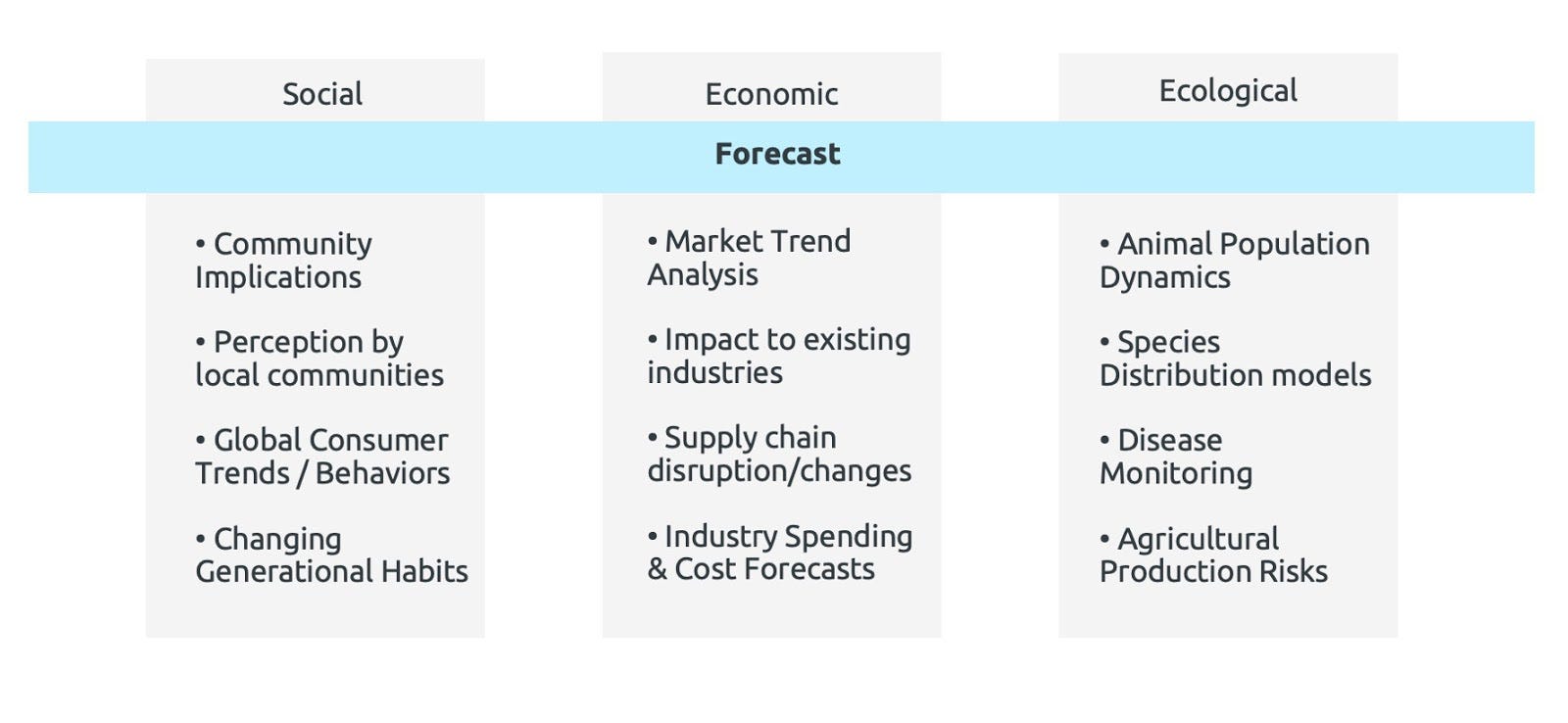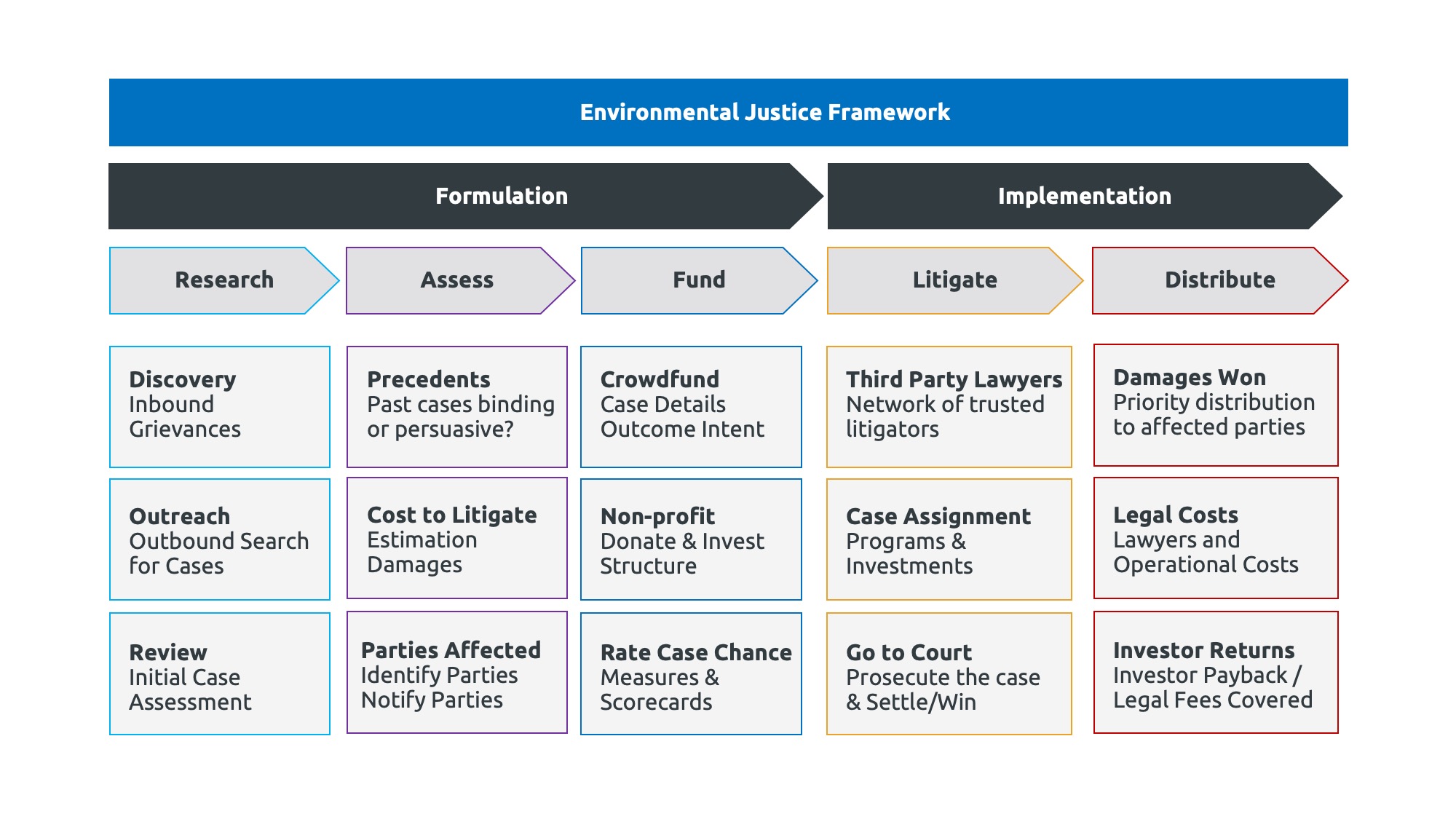My climate journey has been a long time coming, gestating since I first watched An Inconvenient Truth in 2006. I later took a course in environmental studies at Santa Monica College that same year. For the last fourteen years I was always been ‘aware but not active’; I never really did much more beyond recycling, the occasional tree planting, and just being a conscious consumer (whenever the option was frictionless).
In the last three years, I have had opportunities to meet with and interact with a variety of startups tackling climate change issues from thermal energy storage to carbon marketplaces. These opportunities offered me a brief glimpse into the evolving climate change scene; I began to take notes for myself that formed my general sense of the long term opportunities that exist within this space. I never formalized this thinking into anything more than scattered notes until I came across Chamath Palihapitiya’s call to develop a framework for investing in climate change.
This broad framework is how I see the inter-related aspects of climate change and the multitudes of opportunities that exist for investors and innovators alike. I call it the Unified Climate Sustainability Framework.
Abstract
Climate change will affect us all as humans in many predictable ways from temperature upswings, sea-level rises, weather pattern changes, and food production disruption to name a few. All of these will have direct and indirect effects ranging from loss of habitable lands (direct implications) to the migration of potentially billions of people (indirect consequences). These consequences further exacerbate other societal issues from economics to politics; where do these climate change refugees go? How does the society that takes them in adjust to the influx, when their cities are also experiencing their own climate change-related hardships?
Therefore we need to look at decarbonization, climate change & sustainability solutions and investing through multiple lenses; the framework proposed is made of the following approaches:
1) Forecast
2) Address
3) Adapt
4) Mitigate
5) Explore
A holding company that would unify these interconnected approaches under one umbrella would need to consider each for its own merits and devise a profit-driven strategy for each independent of the advantages the totality also brings. It should be noted that one approach should not subsidize another, while it should also contribute to the sum; companies in the portfolio should benefit from one another’s existence and connections.
Forecasting refers to the level of accuracy we can forecast the impact of climate change and how the implementation of solutions from the mundane (solar farms) to the extremes (geo-engineering) will adjust those forecasts. This is a data-driven play that can empower the other approaches but acts as a revenue generator by sharing that data with other organizations. This is done primarily through sensors, data collection, analysis, and management.
Addressing refers to our ability to address the issues identified during forecasting with solutions that exist as well as new solutions. Existing solutions might be capable of addressing the issues but their implementation in the right business model is where the true optimal impact of addressing the problem is realized.
Adapting refers to our ability as a society to adapt to the new realities and what problems will exist in the new realities to be solved. Adapting also refers to the utilization of existing solutions to be adapted for climate change use-cases (think: re-purpose & re-utilization).
Mitigating refers to the acceptance that some aspects of climate change might be too late to prevent and the goal must be to mitigate the harmful effects that are imminent. The question to frame it is, what opportunities exist within mitigation?
Exploring refers to looking ahead at how these same technologies can be used in other industries and how existing industries can be disrupted with technologies that also happen to tackle climate change (for example, decarbonization with EVs vs. ICE automotive industry).
The Framework
The proposed framework has taken a first-principles based holistic process to consider the multiplying effects each approach can have when coupled with the others. This unifying framework allows us to create blue oceans of opportunities by exploring multiple solutions that work in harmony with one another. The same way a full turnkey solution provider considers planning, production, and delivery of a service, we will be looking at climate change solutions by understanding, adapting, creating, and distributing under a single framework.
Starting from the bottom up, we consider the perspectives to be considered for investments and solutions. Each specific lens will consider opportunities and risks that exist, including but not limited to regulatory governance, remediation, and urban planning.
Next up the framework, we have the 5 parallel approaches, tackling climate change in their own contributory way (each to be elaborated further in the following pages). The outcomes we are looking for are Profit-Driven Companies that have measurable environmental objectives which account for societal demand trends. The majority of these investments would be long-term holdings driven by a unified purpose while considering their individual hypotheses on how to tackle climate change. Individually each company taking on an approach within this framework will be successful and impactful, but as Aristotle once said, the whole is greater than the sum of its parts. Companies exist today working towards some of these goals, but they are silo-ed and fail to achieve full potential due to their isolationist approach.
This framework allows for a single holding company to tie these individual companies together under a single umbrella to multiply their solutions’ impact. The cross-lateral opportunities that exist across industries are ever more relevant and paramount when tackling climate change.
Forecasting Climate Change Implications
The premise outlined in the forecasting approach will guide many matters within the framework. In terms of analysis and measurement, we can only measure what we capture thus tools and systems for more accurate tracking are needed. We can only analyze the parts of the picture we can see, thus how we fill those parts is the key to this approach.
The technologies and systems that could make up part of this approach refer to smart sensors and imaging technologies, examples include:
- Planet Labs — private Earth-imaging company (using microsatellites)
- Pachama — developing technology solutions to accelerate the growth of an accountable Forest Carbon Credits market.
- Aclima — hyperlocal air pollution and climate emissions intelligence.
The next component is filling the gaps with the existing abundance of data we have, meaning other data collection and projection technologies are key to forecasting and this same data requires the means and tools to analyze the data. This data will drive other industry decision-makers, from real estate developers deciding whether to engage in projects at certain locations, to tracking the progress being made by other reforestation organizations.
Companies such as UrbanFootprint set a precedent of how data can be used to drive decision making by offering a location intelligence platform for smart cities. The missing variable in such smart city platforms is the environmental impact and climate change forecasting insights.
By ensuring proper investment into forecasting solutions for climate change, it shall enable the other focus areas of the holding company to excel by tapping into those insights and being able to connect dots where others don’t even see dots. This allows the holding company and its portfolio to take a progressive approach in evaluating opportunities but also to explore new grounds ripe for innovation.
Addressing the Challenges
To address the challenges presented by climate change, we must look at the problems that arise from a social, economic, and ecological perspective as laid out in the framework.
Typically addressing the climate change challenge has been positioned as a burden on consumers, although the reality is that industrial use cases account for over 50% of the world energy consumption, from oil & gas, chemicals, metals, food processing, pulp & paper, and minerals. This doesn’t negate that the consumer role of transportation (20% of world energy usage), doesn’t play a role, or the fact consumer habits drive industrial production energy usage. Thus to address climate change we must look at this from all perspectives.
Carbon credit marketplaces play a role driven from a top-down governmental regulatory aspect, which creates an opportunity for marketplace suppliers (reforestation initiatives and the like), but consumer education also plays a pivotal role as industries react to consumer demand.
Furthermore, solutions that would make up this stage of the framework refer to those that tackle the biggest emitters of greenhouse gases from industrial use cases and food production, startups that fit within this thesis include:
- Element 16 — thermal energy storage solutions for industries
- PoliLoop — Bacterial plastic recycling
- Nori — Carbon Removal Marketplace
- iwi — Algae-based nutrition (carbon capture + consumer nutrient)
But also solutions that look at educating consumer’s behavior:
- Open Apparel Registry — open-source map and database of global apparel facilities, affiliations provide transparency for consumers (insights into manufacturing process)
- Netflix/Hulu (streaming services) — Blended education-entertainment distributors of content; shows such as Planet Earth (originally aired in 2006), Down to Earth, Blue Planet, etc. play a role in educating consumers through entertainment.
Adapting to New Realities
We have to also consider some of the impact of climate change that has already begun (change in weather patterns), glaciers melting, and with each of those new problems arising that need to be accepted and adapted to.
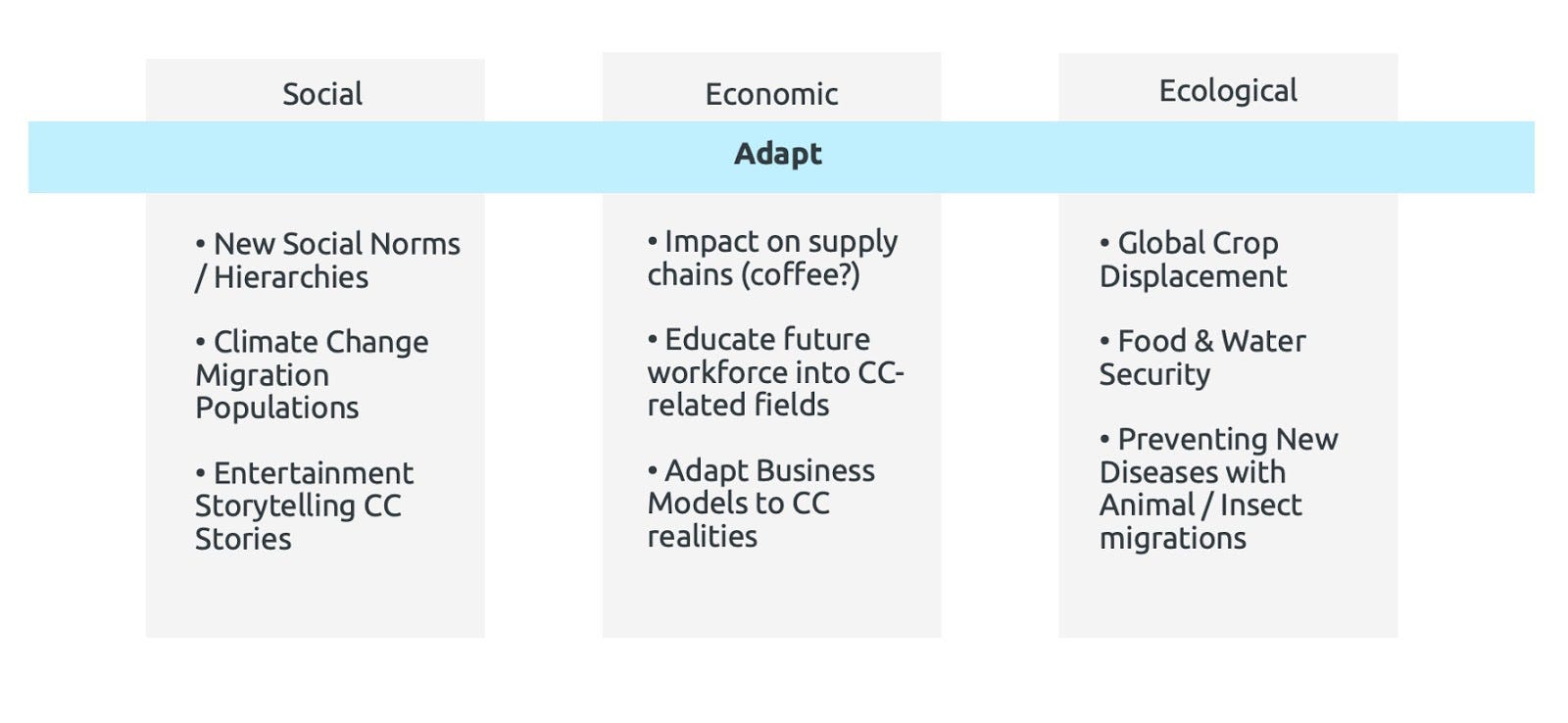
When we consider that climate change is the universal problem to solve across all humanity, we start to reconsider the job roles needed in the future. The same way healthcare is universal and the demand for doctors/nurses has been around for generations, what will the new fields of study that are needed for a changing climate future? Therefore we would also want to look into new education models but with that comes with the reframing and storytelling of the importance of such roles. We have idolized certain job roles in society and skewed away from those critical to longer-term human success from educators and scientists.
For example, if we accept sea levels are rising, we look at solutions that utilize seawater in new practical ways. We would then also look at Mitigating the consequences of these new realities.
- Seawater Greenhouse — brine utilization for cooling and salt production in wind-driven seawater greenhouses
- Beeflow — Bee pollination services for farmers (lower temperatures due to climate change pose problems to natural pollination)
In regards to the future of education, looking at new models of education with hyper-specialization into climate change-related vocations. The structure of education institutions could change when we start to adapt to specialized vocations, as we are seeing with the rise of Income Share Agreements to specialize talent for a ready-to-work placement.
Food & water security will continue to be a problem as our population also expands, thus the rise of alternative protein sources which are more climate-friendly such as the Impossibles and Beyonds of the world will continue to become more viable solutions as consumer tastes also begin to adapt to them. Startups such as Alesca Life, which continue to evolve hydroponic farming solutions to invent new flavors in sustainable manners, will start to penetrate urban areas and bring the rise of urban farmers (aka growers) — a re-labeling/branding will occur.
Mitigating Consequences
In the race to bring climate change solutions to life, there are unintended consequences that are triggered. So how can we both mitigate the effects of climate change and the inadvertent ramifications some of these solutions will cause? (e.g. Job losses in other traditional sectors? Negative supply chain aspects of Electric Vehicles?)
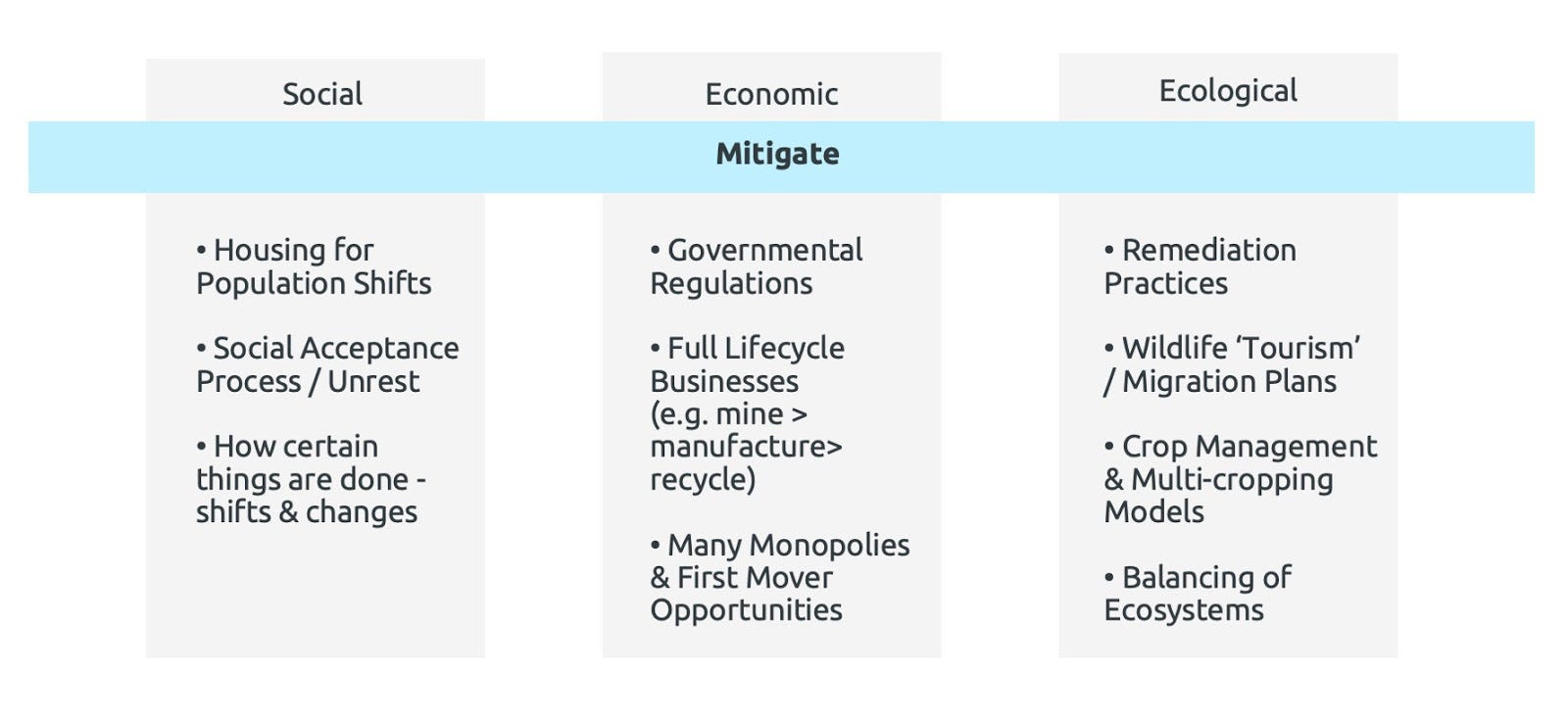
If we are to mitigate the consequences, the solutions that champion this approach would range from those that reduce the disruptive nature of the changes to society. Examples of investments and solutions that fit within this theme (if tackling just the climate change refugee crisis) these companies would be attractive:
- Katerra — Construction housing using Cross-Laminated Timber/Mass Timber.
- BoKlok — IKEA’s joint venture into affordable, sustainable homes.
- Blokable — Modular pre-fabricated production homes.
There are opportunities in optimizing the acquisition and utilization of resources that are needed within the existing and future markets. Simply put, the minerals used to make lithium-ion batteries are often mislabeled “rare earth” due to their difficulty to access however, few if any of them are rare. Thus if we can fully overtake the full lifecycle we can optimize further downstream the process and even upstream in terms of distribution partnerships. While exploring the maximization of rare earth minerals, companies similar to the following are best poised to benefit from the continued demand surge:
- MP Minerals — Rare earth minerals producer
- Boring Company — Tunneling contractor and service company
- Toss Plasma Technologies (now owned by Paradigm Resource Management Corporation) — utilizing RF technology to increase precious metal yields.
Further to mitigate the consequences of climate change, we shall look at the supply process for these industrial technologies from a First-Principles approach and identify startups similar to Aether Diamonds, developing synthetic diamonds, that can supply high-quality industrial-grade diamond tips for boring machines as we continue to explore the Earth’s crust for multiple use cases. Could there be more decarbonization solutions that can fit into other aspects of the supply chain?
Exploration of Future Industries
This last approach looks at what will the future look like, what does an abundance of energy look like? What can we create with a limitless energy source? What do we look for when we have an abundance mindset?
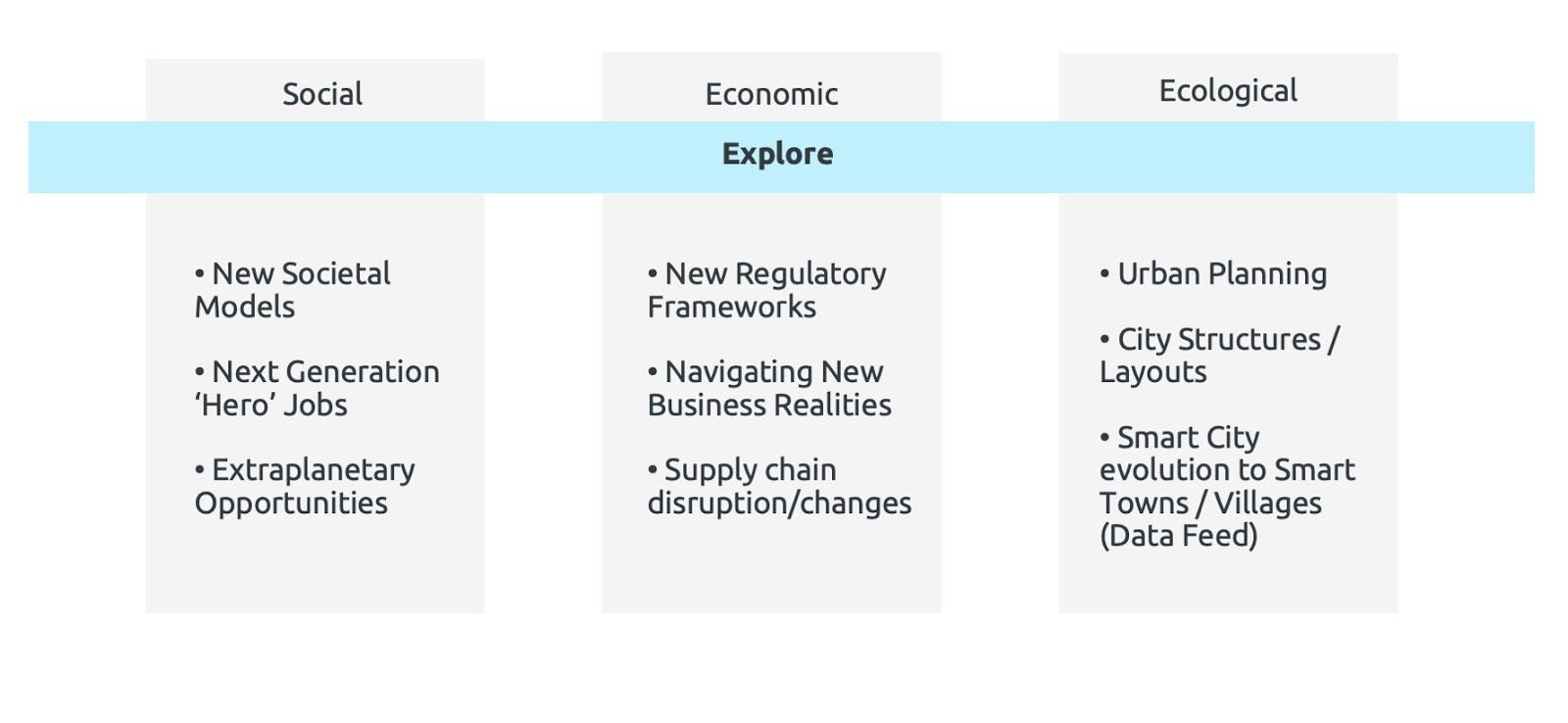
Exploration of new industries could enable us to research what we can do on another planet as the likes of Virgin Galactic, Blue Origin and SpaceX usher in a dawn of space leisure and travel.
What could we grow there? What can we build? What would the adaptation of existing new technologies look like when also coupled with an exploratory outlook?
We would potentially look at exploring the re-purposing of modular housing technology from the mitigation of climate refugees to the creation of extraplanetary housing on other planets.
Furthermore on a social front, by instituting urban planning with an incentive model that creates passive nudges and default behavior towards environmental sustainability, we can change social norms without the need for debate; it can happen organically. Startups such as Aspiration offer financial services with passive sustainability rewarding mechanism with minimal effort from a consumer to change behavior. Such behavioral opt-in mechanics are minimal and it disrupts an activity that otherwise required little effort from a consumer.
Other companies thinking along the lines of an abundance mindset are the likes of Aether Diamonds, creating diamonds from existing carbon sources such as air. Although the process is energy-intensive, if we successfully transition to an energy abundance mindset from hydro, solar, wind, or nuclear power, this would completely open up a new frontier similar to Aether Diamonds; in a sense unveiling the next generation of alchemy.
With the advent of Artificial General Intelligence, how would we look at employing AGI to solve for research aggregation or possibly even researching to speed the discovery of new technologies?
Exploring the world of VTOL and drones, we can imagine new possibilities once we solve for the wind and solar energy storage conundrum especially in smaller divides like drones. We see drones tackling climate change by being used for reforestation, but once energy storage is solved, it would open up the use-case for drones, VTOLs, electric jets, and much more.

